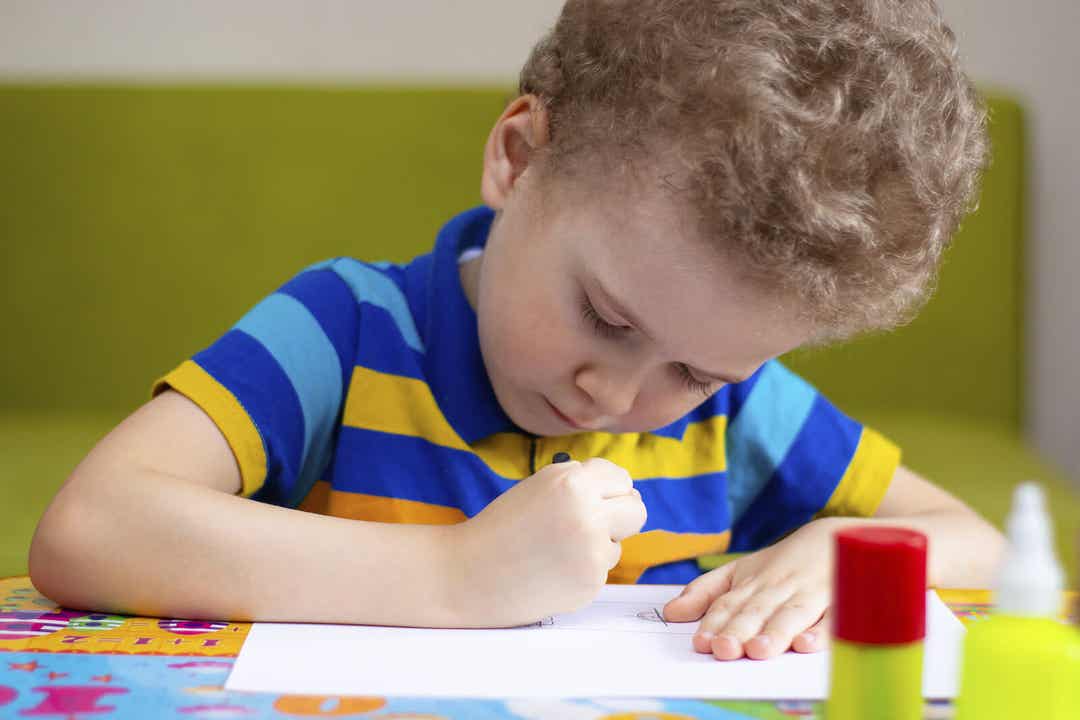The House Test: A Window into a Child's Emotional World

Drawing is one of children’s favorite activities. And anyone who’s spent time with them will know that houses are one of the most recurrent elements in their drawings. However, something so apparently simple and trivial can provide us with important and interesting data about the emotional world of little ones. For this reason, we’re going to take an in-depth look at the house test. What does it consist of and what data it can reveal to us?
The house test is included within the so-called projective tests. Or, more specifically, within the graphic or expressive ones. This means that the drawings a child makes can open a window to their unconscious… To their most intimate experiences.
The characteristic of these tests is that the person doesn’t know what’s being evaluated with them and how. Therefore, the level of resistance or manipulation is minimal. Especially in the case of children, for whom drawing is such a natural and everyday activity.

What is the house test?
The house test simply consists of asking the child to draw a house as they see fit. It’s important not to make any comments that could influence their drawing. Be sure to allow them to do the activity in a totally free way.
When they finish, you’ll have to look at several aspects of their creation that will inform you about different aspects of your child. For example, their emotions, personality, and social relationships.
How to interpret the House Test?
To obtain relevant data from the drawing, we have to look at the shape, size, colors, and elements that make up the house. However, it’s important to emphasize that you must later corroborate the results with other types of tests. In addition, your interpretations must be global and you can’t take the meaning of an element as something determinant.
Size
Open, extroverted, and sociable children usually draw large houses. They tend to be cheerful children who perceive their home as a welcoming place full of well-being. On the contrary, small houses indicate that the child is shy, reserved, or introverted and may feel a certain level of social anxiety.
On the other hand, when the house is significantly tall, it may indicate a child’s need to grow up quickly and gain independence. Likewise, if it’s too low, it may indicate that the child is feeling anxiety, oppression or worry.
Doors and windows
Doors and windows represent the child’s relationship with their environment, their openness to the outside. Therefore, if they don’t draw a door or the door is too small, it’s likely that the child wants to isolate themselves and move away from the environment and social relationships. This would be reinforced if the door’s closed or has a padlock or lock.
On the other hand, if the door is large and open, it’ll indicate that the child is friendly and enjoys relationships. He may even have a tendency to be overly dependent on others.
Large windows, on the other hand, show a child who’s open and eager to explore and learn. While small windows may indicate a certain wariness, caution, and distrust in relationships with others.

Roof and chimney
The roof represents creativity and fantasy. Thus, large roofs, sloping roofs, or roofs that overhang the walls indicate great imaginative capacity. On the contrary, a house without a roof will be a sign of low creativity. In addition, if the roof tiles are drawn in a detailed way, then you’re looking at a more rational and logical personality. If the roof is flat, there may be a feeling of oppression due to an excessively rigid upbringing.
At the same time, the chimney and the smoke coming out of it are a symbol of family relationships. Therefore, if these elements are present, they’ll indicate that the child perceives their home as a warm and cozy place and that there’s good family communication. Their absence will denote a cold home or a lack of communication.
The usefulness of the home test
The above are just some of the many aspects that we have to look at to interpret the house test since, to obtain reliable data, you need to interpret all the elements as a whole.
Moreover, although it’s an indicative test that can provide interesting and valuable information, it’s important to corroborate it later with other more objective instruments.
Drawing is one of children’s favorite activities. And anyone who’s spent time with them will know that houses are one of the most recurrent elements in their drawings. However, something so apparently simple and trivial can provide us with important and interesting data about the emotional world of little ones. For this reason, we’re going to take an in-depth look at the house test. What does it consist of and what data it can reveal to us?
The house test is included within the so-called projective tests. Or, more specifically, within the graphic or expressive ones. This means that the drawings a child makes can open a window to their unconscious… To their most intimate experiences.
The characteristic of these tests is that the person doesn’t know what’s being evaluated with them and how. Therefore, the level of resistance or manipulation is minimal. Especially in the case of children, for whom drawing is such a natural and everyday activity.

What is the house test?
The house test simply consists of asking the child to draw a house as they see fit. It’s important not to make any comments that could influence their drawing. Be sure to allow them to do the activity in a totally free way.
When they finish, you’ll have to look at several aspects of their creation that will inform you about different aspects of your child. For example, their emotions, personality, and social relationships.
How to interpret the House Test?
To obtain relevant data from the drawing, we have to look at the shape, size, colors, and elements that make up the house. However, it’s important to emphasize that you must later corroborate the results with other types of tests. In addition, your interpretations must be global and you can’t take the meaning of an element as something determinant.
Size
Open, extroverted, and sociable children usually draw large houses. They tend to be cheerful children who perceive their home as a welcoming place full of well-being. On the contrary, small houses indicate that the child is shy, reserved, or introverted and may feel a certain level of social anxiety.
On the other hand, when the house is significantly tall, it may indicate a child’s need to grow up quickly and gain independence. Likewise, if it’s too low, it may indicate that the child is feeling anxiety, oppression or worry.
Doors and windows
Doors and windows represent the child’s relationship with their environment, their openness to the outside. Therefore, if they don’t draw a door or the door is too small, it’s likely that the child wants to isolate themselves and move away from the environment and social relationships. This would be reinforced if the door’s closed or has a padlock or lock.
On the other hand, if the door is large and open, it’ll indicate that the child is friendly and enjoys relationships. He may even have a tendency to be overly dependent on others.
Large windows, on the other hand, show a child who’s open and eager to explore and learn. While small windows may indicate a certain wariness, caution, and distrust in relationships with others.

Roof and chimney
The roof represents creativity and fantasy. Thus, large roofs, sloping roofs, or roofs that overhang the walls indicate great imaginative capacity. On the contrary, a house without a roof will be a sign of low creativity. In addition, if the roof tiles are drawn in a detailed way, then you’re looking at a more rational and logical personality. If the roof is flat, there may be a feeling of oppression due to an excessively rigid upbringing.
At the same time, the chimney and the smoke coming out of it are a symbol of family relationships. Therefore, if these elements are present, they’ll indicate that the child perceives their home as a warm and cozy place and that there’s good family communication. Their absence will denote a cold home or a lack of communication.
The usefulness of the home test
The above are just some of the many aspects that we have to look at to interpret the house test since, to obtain reliable data, you need to interpret all the elements as a whole.
Moreover, although it’s an indicative test that can provide interesting and valuable information, it’s important to corroborate it later with other more objective instruments.
All cited sources were thoroughly reviewed by our team to ensure their quality, reliability, currency, and validity. The bibliography of this article was considered reliable and of academic or scientific accuracy.
- Rodríguez, J. M. C. (2012). Estudio de los mecanismos de adaptación y socialización en el dibujo del “Test de la Casa” con una muestra de estudiantes de psicología. International Journal of Developmental and Educational Psychology, 1(2), 183-191. https://www.redalyc.org/pdf/3498/349832340018.pdf
- Hammer, E. (1988). Aspectos expresivos de los dibujos proyectivos. Test proyectivos gráficos, 51-61. https://www.bibliopsi.org/docs/carreras/obligatorias/CFG/15proyectivas/veccia/primer%20cuatri%202020/Hammer%20-%20Aspectos%20expresivos%20de%20los%20dibujos%20proyectivos.pdf
This text is provided for informational purposes only and does not replace consultation with a professional. If in doubt, consult your specialist.








